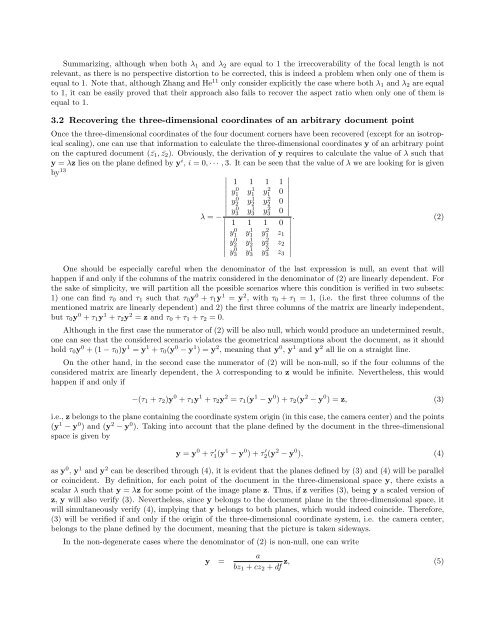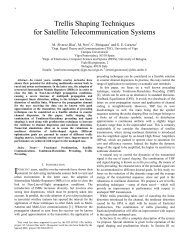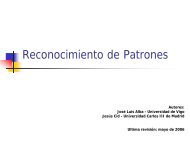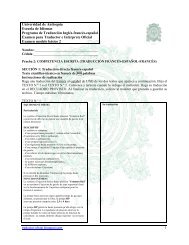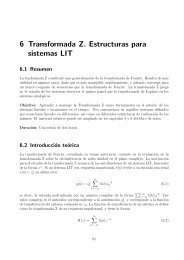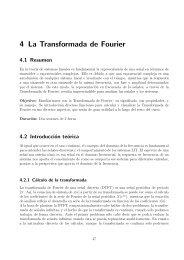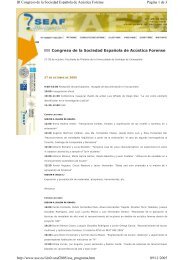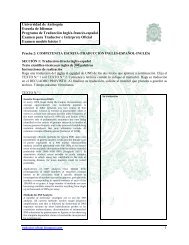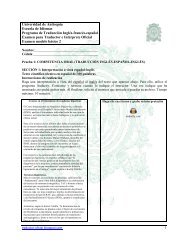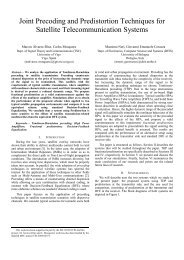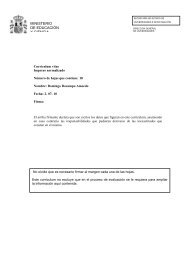A new method for perspective correction of document images
A new method for perspective correction of document images
A new method for perspective correction of document images
- No tags were found...
You also want an ePaper? Increase the reach of your titles
YUMPU automatically turns print PDFs into web optimized ePapers that Google loves.
Summarizing, although when both λ 1 and λ 2 are equal to 1 the irrecoverability <strong>of</strong> the focal length is notrelevant, as there is no <strong>perspective</strong> distortion to be corrected, this is indeed a problem when only one <strong>of</strong> them isequal to 1. Note that, although Zhang and He 11 only consider explicitly the case where both λ 1 and λ 2 are equalto 1, it can be easily proved that their approach also fails to recover the aspect ratio when only one <strong>of</strong> them isequal to 1.3.2 Recovering the three-dimensional coordinates <strong>of</strong> an arbitrary <strong>document</strong> pointOnce the three-dimensional coordinates <strong>of</strong> the four <strong>document</strong> corners have been recovered (except <strong>for</strong> an isotropicalscaling), one can use that in<strong>for</strong>mation to calculate the three-dimensional coordinates y <strong>of</strong> an arbitrary pointon the captured <strong>document</strong> ( ¯z 1 , ¯z 2 ). Obviously, the derivation <strong>of</strong> y requires to calculate the value <strong>of</strong> λ such thaty = λz lies on the plane defined by y i , i = 0, · · · ,3. It can be seen that the value <strong>of</strong> λ we are looking <strong>for</strong> is givenby 13∣λ = −∣1 1 1 1y 0 1 y 1 1 y 2 1 0y 0 2 y 1 2 y 2 2 0y 0 3 y 1 3 y 2 3 0∣∣1 1 1 0 ∣∣∣∣∣∣∣. (2)y1 0 y1 1 y1 2 z 1y2 0 y2 1 y2 2 z 2y3 0 y3 1 y3 2 z 3One should be especially careful when the denominator <strong>of</strong> the last expression is null, an event that willhappen if and only if the columns <strong>of</strong> the matrix considered in the denominator <strong>of</strong> (2) are linearly dependent. Forthe sake <strong>of</strong> simplicity, we will partition all the possible scenarios where this condition is verified in two subsets:1) one can find τ 0 and τ 1 such that τ 0 y 0 + τ 1 y 1 = y 2 , with τ 0 + τ 1 = 1, (i.e. the first three columns <strong>of</strong> thementioned matrix are linearly dependent) and 2) the first three columns <strong>of</strong> the matrix are linearly independent,but τ 0 y 0 + τ 1 y 1 + τ 2 y 2 = z and τ 0 + τ 1 + τ 2 = 0.Although in the first case the numerator <strong>of</strong> (2) will be also null, which would produce an undetermined result,one can see that the considered scenario violates the geometrical assumptions about the <strong>document</strong>, as it shouldhold τ 0 y 0 + (1 − τ 0 )y 1 = y 1 + τ 0 (y 0 − y 1 ) = y 2 , meaning that y 0 , y 1 and y 2 all lie on a straight line.On the other hand, in the second case the numerator <strong>of</strong> (2) will be non-null, so if the four columns <strong>of</strong> theconsidered matrix are linearly dependent, the λ corresponding to z would be infinite. Nevertheless, this wouldhappen if and only if−(τ 1 + τ 2 )y 0 + τ 1 y 1 + τ 2 y 2 = τ 1 (y 1 − y 0 ) + τ 2 (y 2 − y 0 ) = z, (3)i.e., z belongs to the plane containing the coordinate system origin (in this case, the camera center) and the points(y 1 − y 0 ) and (y 2 − y 0 ). Taking into account that the plane defined by the <strong>document</strong> in the three-dimensionalspace is given byy = y 0 + τ ′ 1(y 1 − y 0 ) + τ ′ 2(y 2 − y 0 ), (4)as y 0 , y 1 and y 2 can be described through (4), it is evident that the planes defined by (3) and (4) will be parallelor coincident. By definition, <strong>for</strong> each point <strong>of</strong> the <strong>document</strong> in the three-dimensional space y, there exists ascalar λ such that y = λz <strong>for</strong> some point <strong>of</strong> the image plane z. Thus, if z verifies (3), being y a scaled version <strong>of</strong>z, y will also verify (3). Nevertheless, since y belongs to the <strong>document</strong> plane in the three-dimensional space, itwill simultaneously verify (4), implying that y belongs to both planes, which would indeed coincide. There<strong>for</strong>e,(3) will be verified if and only if the origin <strong>of</strong> the three-dimensional coordinate system, i.e. the camera center,belongs to the plane defined by the <strong>document</strong>, meaning that the picture is taken sideways.In the non-degenerate cases where the denominator <strong>of</strong> (2) is non-null, one can writey =az, (5)bz 1 + cz 2 + df


